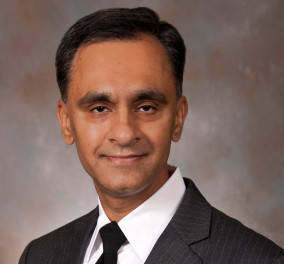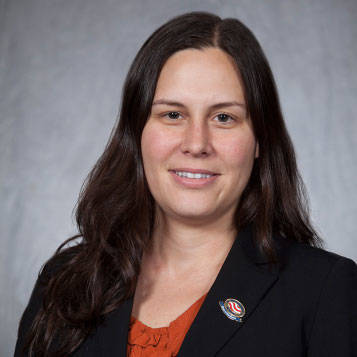Mohammad Naeem, MD, FACR, Co-Chair of the American College of Radiology® (ACR®) General, Small, Emergency and/or Rural Practice (GSER) Network Military Subcommittee, contributed this piece.
In July 2020, I was tapped to be the 20th director of America’s most prestigious military radiobiology research facility, the Armed Forces Radiobiology Research Institute (AFRRI). AFRRI is a unique national asset, celebrating its 60th anniversary this May 2021. The institute, under the command and control of the Uniformed Services University of the Health Sciences (USUHS), is responsible for preserving and protecting the health and performance of U.S. military personnel operating in potentially radiologically-contaminated multidomain conventional or hybrid battle spaces and urban environments. AFRRI engages in research, education and operational training to advance the understanding of the effects of ionizing radiation, in line with the 21st-century dynamic threat landscape and national security threats posed by non-state actors, hostile state actors and near-peer adversaries. In addition, AFRRI provides rapidly deployable radiation medicine expertise in response to a radiological or nuclear event domestically or abroad.
Radiologists and radiology organizations are in a unique position to be leaders in radiation accident preparedness and response. Our in-depth understanding of ionizing radiation, radiation-induced injury and principles of radiation protection postures us well to serve as experts to our hospitals and other medical authorities. As the first radiologist and first ACR Fellow to lead AFRRI, I feel that AFRRI and the ACR can very closely cooperate in the arenas of emergency radiology and disaster preparation education at the national level.
On May 12, 1961, Secretary of Defense Robert McNamara established AFRRI based on two cold war ground realities of that time – the threat scenario of numerous Soviet infantry divisions overcoming the Fulda Gap defenses in West Germany and overtaking western Europe, and the use of nuclear weapons on the battlefield by the North Atlantic Treaty Organization forces particularly enhanced radiation weapons rich in neutron output, to halt such a massive assault from the Warsaw Pact countries.[i]
AFRRI is the U.S. Department of Defense’s (DoD’s) only medical research and development facility dedicated to nuclear and radiological defense. The Institute’s touchstone research projects, as a key component of USUHS, include biodosimetry, combined injury, internal contamination and metal toxicity, effects of low dose radiation and radiation medical countermeasures development. It routinely collaborates with other military and government organizations in the arenas of civilian radiological-accident response and with the National Aeronautics and Space Administration on the safety of astronauts exposed to cosmic radiation.[ii]
The Institute has also been at the center of medical and radiobiological matters pertaining to radiological-nuclear incident response, maintaining a rapidly-deployable team of radiation subject matter experts, including physicians and physicists, to support medical response and actions taken in military and civilian nuclear or radiological incidents, either domestically or abroad. During the U.S. DoD response to the Fukushima Daiichi reactor incident, Operation Tomodachi, the Medical Radiobiology Advisory Team, which is the operational arm of AFRRI located at Naval Support Activity Bethesda in Maryland, provided guidance and advice to the U.S. military leaders in Japan. This support helped ensure the safety of U.S. service members, family members and civilians, and supported the humanitarian relief in a coordinated effort with the Government of Japan.[iii] AFRRI routinely trains military and civilian healthcare providers, disaster-preparedness personnel and operational planners on the medical effects of ionizing radiation and the logistical and medical responses to radiation exposures.
In today’s complex international security environment, non-state actors may attempt to detonate radiation dispersal devices, such as dirty bombs or improvised nuclear devices, in major urban centers. [iv] Near-peer adversaries or hostile state actors may use tactical or low-yield nuclear weapons in a battlespace against the U.S. and its allies. A nuclear weapon detonated in earth’s low orbit by a near-peer adversary can create a massive electromagnetic pulse, rendering the electronic equipment ineffective on an unimaginable scale.[v] This clear and present danger needs our immediate attention and preparation. AFRRI proudly stands ready as the frontline radiobiological research center and medical operational asset in the radiological defense of the nation for 60 years.
Please share your thoughts in the comments section below and join the discussion on Engage (login required).
[i] DEFENSE’S NUCLEAR AGENCY, 1947 – 1997; DEFENSE THREAT REDUCTION
AGENCY, U.S. DEPARTMENT OF DEFENSE, WASHINGTON, D.C., 2002, pg. 206.
[ii] National Research Council 2014. Research on Health Effects of Low-Level Ionizing Radiation Exposure: Opportunities for the Armed Forces Radiobiology Research Institute. Washington, DC: The National Academies Press. https://doi.org/10.17226/18732.
[iii] VanHorne-Sealy J, Livingston B, Alleman L. DoD’s Medical Radiobiology Advisory Team: experts on the ground. Health Phys. 2012 May;102(5):489-92. doi: 10.1097/HP.0b013e31824acb08. PMID: 22469928.
[iv] https://www.wjperryproject.org/
[v] https://www.militaryaerospace.com/communications/article/16709112/todays-battle-for-the-electromagnetic-spectrum


